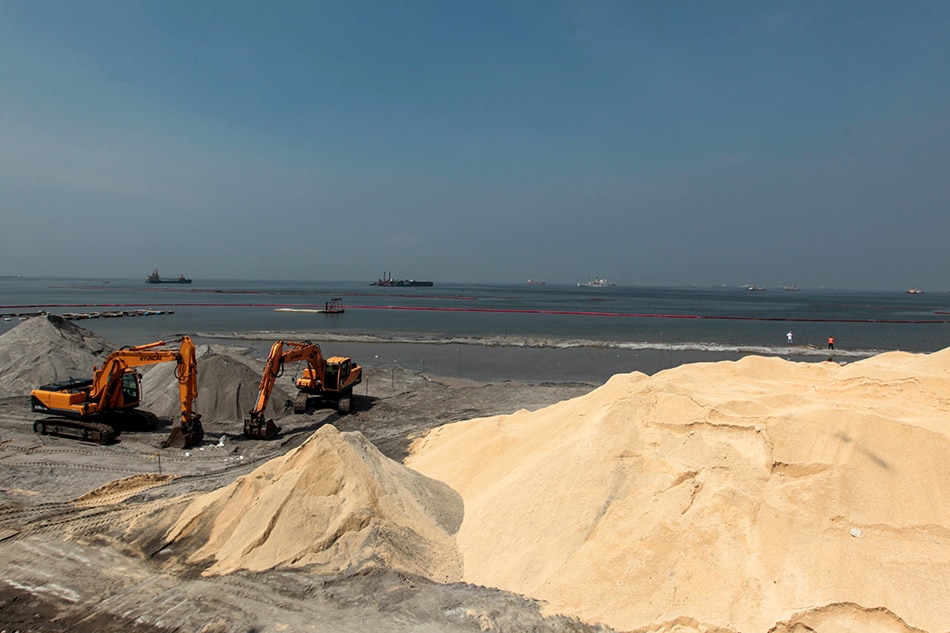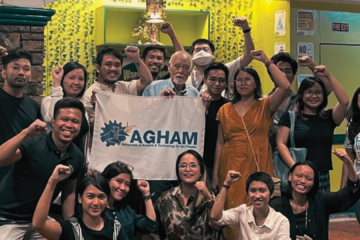By Mark Angelo C. Bucay
This article was originally published in Bulatlat.

The costly dumping of dolomite to the Manila Bay in the middle of a pandemic is a very grim metaphor of the sorry state of our natural resources management. It ignores the more important need of the people for health care and the technical views from science workers.
Misplaced funds, misplaced priorities
The dolomite issue exposes the state’s misplaced priorities. While the archipelago is turning into a petri dish of coronavirus, the environment agency continues to waste precious funds on the dolomite beach. The Department of Environment and Natural Resources (DENR) claims that the project is meant to raise the population’s morale and bring the picturesque white sand tropical beach experience closer to the people in the capital. However, when we say we need a cleaner Manila Bay, we don’t mean it to be a costly, artificial beach overlay while the water quality is still subpar the standards. Cleaning Manila Bay doesn’t mean focusing the bulk of the funds on the costly artificial beach of the 500-m coastline stretch [1] yet approving environmentally destructive projects [2] on the other portions of190-km coastline [3].
If there is one thing that the pandemic reminds us of, it is the fact that humans are no more than mortal components of the biosphere; that in our pursuit of development, one must consider how we can move forward without compromising the integrity of our natural ecosystems. Spending millions of pesos on a short portion of the entire coast, while millions of people are suffering, isn’t simply a disregard to what the pandemic has taught us, but also an absurd sense of priority for an agency mandated to protect the environment.
Digging our mountains, while burying our seas
The dolomite issue exposes how we are corrupting our mountains and seas. Extracted from the towering karst ridges of Cebu, the dolomite is now serving a bizarre artificial role to give “whiteness” to the deteriorating Roxas Boulevard coast. Ridge-to-Reef is an ecological approach simply indicating that what happens on the uplands will eventually affect what’s on the coasts and on the seas. In the metaphor that we are in, we can say that the massive privatization of our state-owned minerals mirrors what’s happening on the coast. We are digging our mountains, while burying our seas.
In the mountains, digging minerals for the sake of profit is nothing new. The country sits on a pot of gold, quite literally. Metallic and non-metallic minerals are deposited in many of our islands. In 2020, we recorded a total mineral export of USD 5.20 billion. We constantly export large tonnage of nickel, gold and chromium [4]. Last year, we were the second largest exporter of nickel [5]. It sounds good for our export-oriented economy but value-wise, we are selling low-value muds and stones while buying high-value brasses and steels.
Our country remains largely unindustrialized. We are not manufacturing our own metals from our very own muds and minerals. We dig and sell them at the expense of environmental damages. Our environmental laws provide no mitigation strategies that can reverse the damaged sites into their once pristine states.
In the sea, massive reclamations in the coast for many big and foreign corporations are already approved, particularly in Manila Bay. This is a very stark contrast to the restoration of the Bay’s natural habitats. The dolomite beach is just a speck of what will happen to the entire Manila Bay. Approved projects come in different sizes, shapes and locations that, once completed, our cartographers will have to digitize almost a completely different coast for Manila Bay.
Of course, along with these activities in the mountains and the seas, we hear the usual “development” mantra- “more job opportunities, “better infrastructure”, “more foreign investments”. But can we really call it development when the environment and the local communities suffer? Can we really call our environmental policies effective, when so-called rehabilitation plans are reduced to mere aesthetics and profiteering and not answering what is just and what is right for the people relying on the mountains and the seas for their survival?
Silencing science, killing defenders
The dolomite issue exposes how the state considers criticisms and scientific evidence. Scientists from various fields urgently gave technical advice to the government against the dolomite project. What did the scientists get in return but backlashes? They were demonized and even accused of being “bayaran”. This reflects how the state responds to science. Science, as a tool, is objective in itself. But when scientific findings do not support the views of those in power, will these findings be heard?
This response reflects the overarching ignorance to science of those in position, especially if the findings aren’t in line with their personal political gains. The way our environmental scientists are ignored has been going on for decades. Victims of contractualization, limited job opportunities, and miniscule fundings, science workers are held up to the highest standards yet have been receiving very little.
But the power held by the environmental corrupters isn’t limited to financial advantages. It can mean literal power that kills. According to Global Witness, the country is the worst place for environmental defenders in Asia, and consistently on the top three bloodiest countries in the world for environmental defenders for five years. In these islands, power-relations conflicts ultimately lead to killing of our defenders.
No amount of artificial overlay can hide our islands’ ugly truths
The dolomite controversy exposes the vulnerable state of our environment, how our laws fail to protect nature and the locals, and how people in power can easily dismiss our archipelago’s welfare for money-making. Dumping of the dolomite sand to improve the aesthetics of Manila Bay is no more than a rhetoric of the country’s environmental policies and implementation—a picturesque representation that tries to conceal the real state of our eroding mountains, emptying seas, and monopolized lands. Still, it cannot hide the fact that on these beautiful islands and coasts, the people are sick and starving, and the soils blood-soaked.
About the author:
Mark Angelo C. Bucay is a graduate student in Biogeography. He has several works on ecological dynamics of various degraded ecosystems such as mining areas and industrialized coastal zones. He is a member of AGHAM-Food Security and Self-Sufficiency.
Endnotes
[1] Releases from the DENR indicate that the initial dolomite beach will have a length of stretch to about 500 meters, excluding the planned expansion of the dolomite beach to nearby coast of Roxas Boulevard.
[2] Portions of Metro Manila and Cavite will be subjected to numerous reclamation activities as approved by the Philippine Reclamation Authority and DENR. More reclamation activities are also designed in the Northern portion of the coast including the Bulacan Aerotropolis
[3] Several research from Jacinto, Siringan, Gil and Villanoy estimated the total length of Manila Bay coast at 190km, Manila Bay Atlas from NAMRIA also indicated the same figure from Cavite to Bataan points of Manila Bay Basin.
[4] Data from Mines and Geosciences Bureau updated July 2021, indicates Nickel, Gold and Chromium as top mineral products of the Philippines.
[5] United States Geological Survey’s report on World Nickel Production indicates Philippines as the second top nickel producer next to Indonesia.

0 Comments